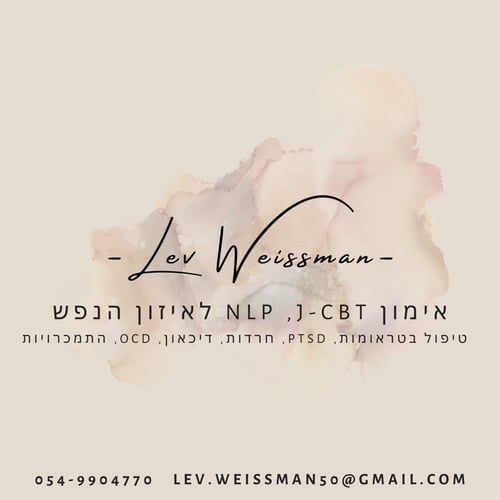© Dr. E. Bernstein (Ph.D.) (a), (b).
TEACHING PSYCHOTHERAPY AS A BRIDGE IN A
MULTICULTURAL ENVIRONMENT (c)
A. Abstract
Approximately one million Israelis live in the Upper Galilee, incorporating many of religious trends in Judaism, Islam, Druze and Christianity. The religious beliefs of the above-mentioned groups, who live in separate communities and whose connection with each other consists mainly of business relations, with very little social contact, are reflected in daily life and are expressed in both normative and pathological psychology.
A model of psychotherapy studies is presented as one that also acts indirectly as a bridge in a multicultural environment. Students from all the different populations, sects and religions in the Galilee participate in the three-year diploma program in Psychotherapy, at the Safed Regional College. The course enables students to acquire special skills in coping with various mental disturbances. The study process takes place on the overt level (acquisition of skills) and on the covert level, where
psychological mechanisms are internalized. These mechanisms are important for understanding the “different other” and include “the ability
_______________
(a) Senior clinical Psychologist. Head of Postgraduate Program for Psychotherapy.
Safed Regional College, Safed, Israel.
(b) Clinical Director. “Shalem” Institute for Psychotherapy, Psychodiagnostics
and Supervision, Rishon LeZion, Israel.
(c) Paper presented at the Fifth Conference of the Adult Section of the European
Federation for Psychoanalytic Psychotherapy in the Public Sector (EFPP), Dresden,
Germany. May 2005. "Crossing Borders – Integrating Differences".
to listen”, “acceptance”, “containment”, “empathy” and “testimony to the narrative of the client”, all essential for the bridging processes in a multicultural environment, as well as in areas unconnected to mental health.
B. Background Reflections
Metaphorically, Psychotherapy is “The Art of the Fugue” that exists in words. At its best, it combines the three dialogues that take place within it, in perfect timing or synchronicity : (1) the conscious dialogue spoken and heard between the therapist and the client, (2) the dialogue taking place between the client and his inner self that is present in the preconscious of the therapeutic state, and (3) the dialogue that is gradually developing but is so far concealed from the client who is conducting it with himself in an unformed language - a language belonging partially to the unconscious. These three dialogues are like three topics, or themes, that follow on from each other and rise up in harmonious orchestration when combined with one another. This completes the analogy with the world of music. What is unique here is that just as with music, so with psychotherapy – the most momentous events take place in an environment produced by a “language” creating experiences that are emotional, significant and mainly non-verbal. In my opinion, the expressions “corrective emotional experience” and “insight” indicate a fourth dimension that is inherent to psychotherapy. At this stage, I propose that we describe this dimension as a “capability to collect the subjective experience” in favor of what Martin Buber calls an “I-Thou” encounter , a transcendental concept containing what Stern et al. might call “now moments”, over an extended time period. These experiences have a large part in creating the basis of a mutual understanding between professionals in a multicultural society. I will mention three aspects that do much to promote bridging and a sense of cooperation in societies that are divided both culturally and politically, and that could contribute even to a minor degree to the “harmony in concert” that is formed in a therapeutic environment.
C. The Safed College
The Safed College is situated in the Upper Galilee area of Israel, in the city of Safed. Safed has long history (over 2,000 years) as a district capital city and a crusader fortress, and was the seat of the Turkish Government when the Ottoman empire ruled the Land of Israel. The city, lying 900 meters above sea level and overlooking the Galilean hills, has an enchanting, mystical aura about it, and was central to the Jewish Lurian kabbalistic movement during the 17th century, an aspect that characterizes the city till today. Until 1948, Safed had a mixed population of Jews and Arabs whose coexistence was enforced and unfortunate. When the State of Israel was created, Safed became a totally Jewish town with a varied population that included both secular and religious Jews. Religious settlement in Safed has been very influential. Its Jewish/Hassidic/Kabbalistic past is made conspicuous by the different types of dress codes of some of its inhabitants The Galilee is characterized by a multicultural and multinational population; Jews, Moslems, Druze and Christians of every religious and political faction. Some 1,000 students, about half of whom are not Jewish, attend the Safed College, which is a branch of the religious university of Bar-Ilan – the 2nd largest university in Israel. Daily contact in the study framework between students of the different religious factions rarely crosses the bounds of academic professionalism. Since the start of the second Palestinian Intifada in September 2001, the rupture has become even deeper. After a terror attack that took place nearby, an influential Jewish minority group demanded that Arabs should be forbidden entry to Safed. At the same time, the Arab population of the Galilee began looking for alternatives to Jewish academic institutions.
D. The Three-Year Psychotherapy Program at the Safed College
The three-year psychotherapy program at the Safed College, which was established in the year 2000 by a group of people working at the Community Center for Mental Health at the Rebecca Sieff Government Hospital in Safed, was given academic recognition that same year by the College. The majority of the teaching staff are senior professionals in the mental health sector (psychologists, psychiatrists, social workers etc.) and work intensively using dynamic psychotherapy both at the community center and elsewhere. Their aim is to familiarize their colleagues working in the different areas of mental health with the principles and practice of dynamic psychotherapy. 14 students are accepted to each course, the prerequisite being either a bachelor’s or a master’s degree in one of the professions connected to mental health, and experience in guided clinical work in a recognized professional institution. During the three-year program, all the students take 4 courses every Monday and also participate in a therapeutic supervision group. They are requested to treat clients from the Center for Mental Health (children, adolescents and adults, in outpatient clinics or on the wards), and their work is supervised by the senior staff. The Community Center for Mental Health, or “Psychiatria” – as this institution is better known locally - offers therapeutic services to a regional population of around 250,000. Potential clients include Jews, Moslems, Druze and Christians living in the Galilee area.
The three-year psychotherapy program at the Safed College also includes postgraduate students of psychotherapy from all sects and religions. We maintain that the study of psychotherapy in mixed ethnic groups, based on “transcultural” psychotherapeutic activities, can form a durable bridge for mutual understanding in places where different ethnic, nationalistic and political opinions abound. To present this thesis beyond the banal truth that exists therein, I would like to offer three contentions that will be validated in the following three examples:
E. Bridging Elements – Examples
(1) Empathy is at its best when mutuality is present:
Empathy takes place in an interactive matrix between therapist and client. It is my contention that within this framework, the therapist can only empathize with the client when he or she(d) is quite clear in regard to his present subjective standpoint, which is totally separate from that of his client. This type of separation illuminates the therapist’s thoughts, thereby preventing the possibility of his feelings becoming mixed up with those of his client. This “illumination” is a precondition for every situation involving listening, contemplation and analytic investigation. Only when the therapist is able to honestly expose the elements of his true self to himself can he form a dialogue with the client’s inner self.
Example: A 35-year old Moslem man is admitted to the psychiatric ward after his first psychotic onset with hallucinations that were paranoid and agitated in nature, the contents of which involved a physical struggle with a Jew who wanted to plough his land. He refused to participate in group therapy led by a female Moslem therapist, with the excuse that “she collaborates with the Jews”.
In a supervision session with her Jewish supervisor , she gives vent to this insult that she considers “unjustified”. The supervisor recommends patience and self-restraint, which naturally does not help the therapist at all at this stage.
Two months later, the therapist goes to Jordan to visit her family. She returns with mixed feelings; on the one hand happy after a family reunion (her first meeting with family that used to live in the Galilee), but on the other hand, concerned about the way she was looked upon in Jordan as a “collaborator” because of her work in an Israeli mental health institution. In another supervision session, she talks about the parallel between the reactions of her family in Jordan and that of the psychotic client two months previously. The clarity with which she reaches an understanding for herself, by means of which she concludes that she is absolutely not a “collaborator”, leads her to discover the familial aspect in the ethnic kinship between her family in Jordan and the psychotic client, whom she considers a “lost brother”. All at once, the feeling of insult disappears and is replaced by the seeds of understanding of psychotic contents, followed by an appreciation of her client’s personal distress. She is able in an indirect way to use behavioral parameters that make it clear that she is interested in becoming closer to him in a professional sense. A short while later, the client tells her: “I understand that you have to behave as a partner of the Jews you work with. Otherwise you won’t have a chance to move upwards in your profession”.
(2) Transcendent elements leading to partnership
Sometimes a mutual bond can be formed based on cultural elements that, in spite of daily differences, have components of partnership. Elements such as these can be found in the solidarity that develops on a common ground of belief in God and a willingness to keep religious commandments, while at the same time being able to understand transitions from one culture to another.
Example: An 11-year old Druze girl is admitted to hospital after a desperate attempt at suicide. Her mother is a single parent (a rare occurrence among the Druze), who became a partial outcast by the religious establishment in her home community, and as a result, had to move to a town inhabited by Jews. The therapist is a female Moslem clinical psychologist, who is strictly religious. The supervisor in the therapy sessions is a religious Jewish man, from western Europe, entrenched both in western and traditional Jewish culture. The therapist and the supervisor are, as it were, “people with more than one culture”.
Both the therapist and the supervisor are ideologically against suicide attempts. In their religious consciousness, a person who attempts suicide should be excommunicated. A number of questions are raised in the Supervision session. After all, it is the mother who was excommunicated, not the daughter. During supervision, which is accompanied to a great extent by the religious linkage of the professionals, the subject of the “outsider” or the “stranger” in society is raised and a discussion ensues about the sense of “strangeness” and “otherness” of the therapist in her Jewish work environment on the one hand, and the supervisor in his European world (prior to his immigration to Israel), on the other. The discussion of questions unconnected to therapy, as it were, that certainly contains elements of countertransference connected to the client, leads to a deeper mutual understanding between the supervisor and the therapist, and over time creates a work pact between them, leading to a stage where the girl’s mother decides to receive therapy and including parental guidance for herself. Simultaneously, the therapist and the supervisor were successful in their joint attempt to help reinstate the mother in her own former community.
(3) Language as an alienating factor, and alienation as a basis for consolidated mutual socialization
Learning in one dominant language is typical of academic institutions that exist in a multilingual environment. Studies in the Safed College are carried out in Hebrew. The spoken language of the Arab students is Arabic. For various reasons the Arab students find it difficult to read study material in English. The psychotherapy program includes “guided reading sessions” for both Jewish and Arab students who need extra help. We noticed that use of a language that is foreign to both sectors during the course of the guided reading, led to a sense of comfort that we were unaccustomed to during regular lectures. We wondered whether the use of a foreign language reduces mutual distrust and would encourage the socialization process that develops during joint studies.
Example: A short time after the second intifada broke out, a terrorist exploded himself on a bus that was on its way to Safed. The circumstances led authorities to suspect that two Arab students from the college had prior knowledge and did nothing to prevent the terror attack. Jewish citizens with influence at the college demanded that Arab students be forbidden to enter the town, to prevent further attacks. As a reaction to this, one of the Arab students in the psychotherapy course stopped attending out of fear for his safety. The student, a clinical psychologist who had completed his studies in Germany, complied with my request and agreed to come in my car to Safed, on the condition that I pick him up from his home about 20 kilometers away from the college. I imagine that the fact that I speak fluent German helped us to form a special bond. Maybe the fact that we used to review together professional literature in German, was also a deciding factor in his willingness to join me. On the journey, and later on during the break between lessons, we would talk – in German, which he spoke very well. We did not notice and probably would not have felt it at all had the other students not commented that we were “talking in a language that nobody understands here”. From the moment this was mentioned we both realized that speaking a language that was “foreign” to the place, yet to some extent also “foreign” to us too, we had created an “intimate distance” that enabled joint discussion. Our closeness was apparently facilitated by means of a separating but at the same time a joining aspect. I was reminded of something a friend of mine from East Germany told me in 1985, when the Berlin wall was still dividing the two parts of the city: “The wall dividing us is common to all citizens of Germany – both East and West”.
In my presentation today I have attempted to convey how the study of psychotherapy can bridge social, ethnic and political gaps in a multicultural environment. I am convinced that this concept has excellent chances for success and should be open to further discussions development.



